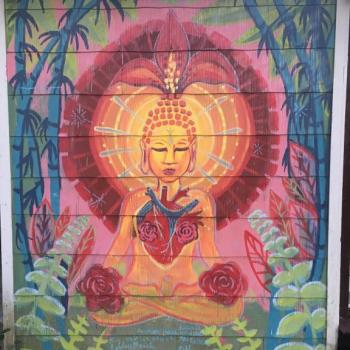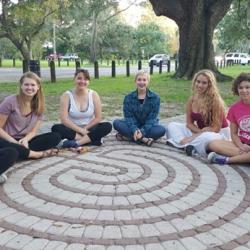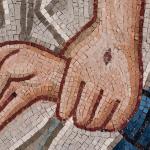Today when I went to walk at the labyrinth in Audubon Park, a man was pulling some of the bricks out and cleaning them. He had his headphones on and he was looking down. I didn’t want to startle him by walking on the labyrinth without asking permission, so I tried various different ways of getting his attention. Finally, I squatted down and waved my hand right where he was working. I was worried he would be mad, but he was very friendly. It turned out he was the man who built the labyrinth, a guy named Marty Kermeen.
I figured this was a God moment so I engaged him in conversation. At first, Marty was interested in trying to get me to buy a labyrinth for my campus ministry. They’re only $4000 for a cloth one or $50,000 for a brick one. I listened attentively and politely. then then it happened. He stopped being a salesman and lost himself in the wonder and beauty of his art.
He told me that labyrinths had very ancient origins around the world. The same basic pattern was found in cultures as far apart as the ancient Hindus and the ancient Celts with no evidence of influence between the two. Labyrinths found their way into Christianity when monks started drawing them in the margins of the biblical manuscripts they were copying. Then cathedrals like the famous Chartres Cathedral became to incorporate the labyrinth in their design.
What I learned about the Chartres Cathedral labyrinth is that the center circle contains six circles which encircle a single middle circle. I had never learned this, but this is the geometric perfection of the number seven. You can surround a single circle with exactly six circles of equal size that touch at their edges and do not overlap. Marty told me to try it with Mason jars at home.
Marty shared that the number seven is a combination of the number three, which represents the divine trinity, and the number four, which represents the Earth due to the four cardinal directions and other aspects of spatial reality (left, right, forward, behind). One other realization that came to me is that the two biblical numbers are both a combination of 4 and 3: 7 is 4 + 3 while 12 is 4 * 3.
Another detail about the Chartres labyrinth that blew my mind is that its diameter is almost exactly one millionth the diameter of the Earth. It was built long before Columbus or Galileo. Maybe there was some other basis for analyzing the Earth’s diameter, but it’s still an amazing feat.
Finally, he number of steps from the entrance of the labyrinth to the center is 279, the days of gestation for a human baby, which makes sense in a cathedral devoted to the Virgin Mary.
I’m not going to try to go Da Vinci Code with any of these trivia points. There are a bunch of other intricacies that Marty shared very quickly that I couldn’t remember. When I asked Marty how in the world anyone could create something with this complex combination of elements, he said they took a hundred years to build that cathedral. That’s what really blew my mind. Imagine starting to work on a piece of art that would not be completed until after you were dead. Imagine having to trust your children and grandchildren and great-grandchildren to complete your work. How could anyone devote their entire lives to creating something that they wouldn’t be able to enjoy themselves? It seems so tragic to our sensibilities today.
What God seemed to say as I walked the labyrinth and pondered these things is that true beauty is created in the context of authentic worship. It requires an incredible level of devotion to create something as intricate as a cathedral, of which the labyrinth is only a small part. I’m not saying that all beauty is derived in a form of worship that knows and names God with perfectly precise Christian orthodoxy. But cynicism, the opposite of worship, cannot produce beauty except insofar as it is tricked by worship into doing it. The tiniest amount of poignancy in words or design must have some form of delightful wonder at its source. Even if I write a bitter, caustic poem, its aesthetic power does not come from the anger but from the love of language that transforms anger from an impotent scowl or crude act of violence into moving, cathartic eloquence.
Perhaps this little theory is nonsense. Regardless, I’ve become increasingly convinced that the way to talk about Christian salvation is that it is our awakening to beauty, or if that doesn’t sound Jesusy enough, our embracing of the eucharistic life. Here’s how the apostle Peter puts it:
His divine power has given us everything needed for life and godliness, through the knowledge of him who called us by his own glory and goodness. Thus he has given us, through these things, his precious and very great promises, so that through them you may escape from the corruption that is in the world because of lust, and may become participants of the divine nature. [2 Peter 1:3-4]
Beauty names the holy reality that is not cheap and tacky with worldly corruption. It can be found everywhere, even in the midst of great sin. But to gain a full taste of beauty requires a palate that is clean from idolatry. It requires my liberation from the relentless need to turn everything I do into self-justification. The experience of beauty cannot coexist with self-absorption. My heart needs to be entirely empty and open to worship, which is why I must be crucified and resurrected with Jesus. Prayer labyrinths are an important tool in my journey to union with Christ.













